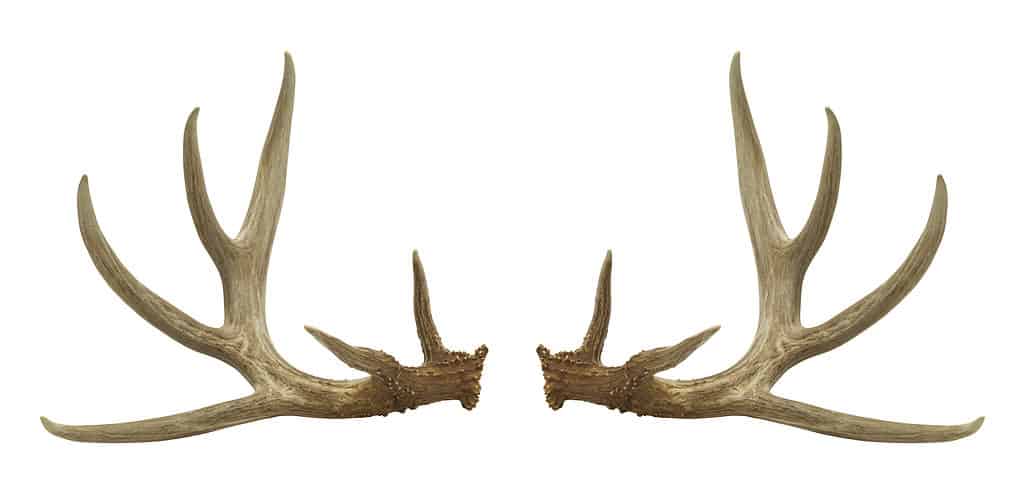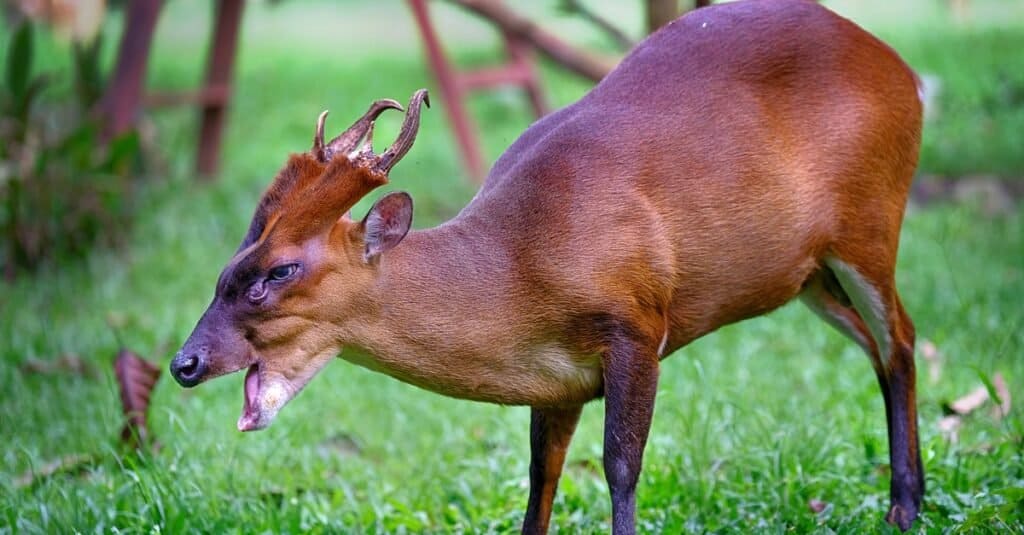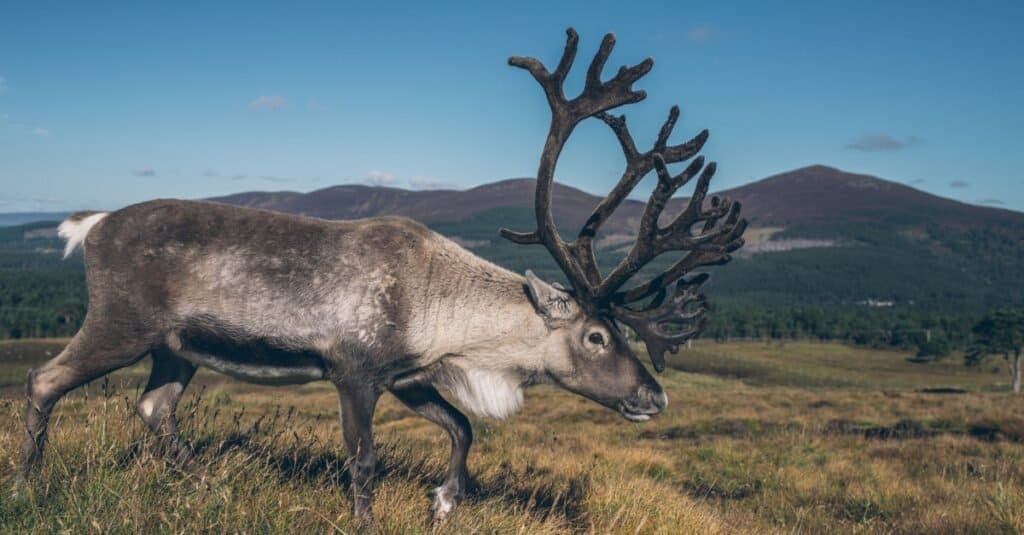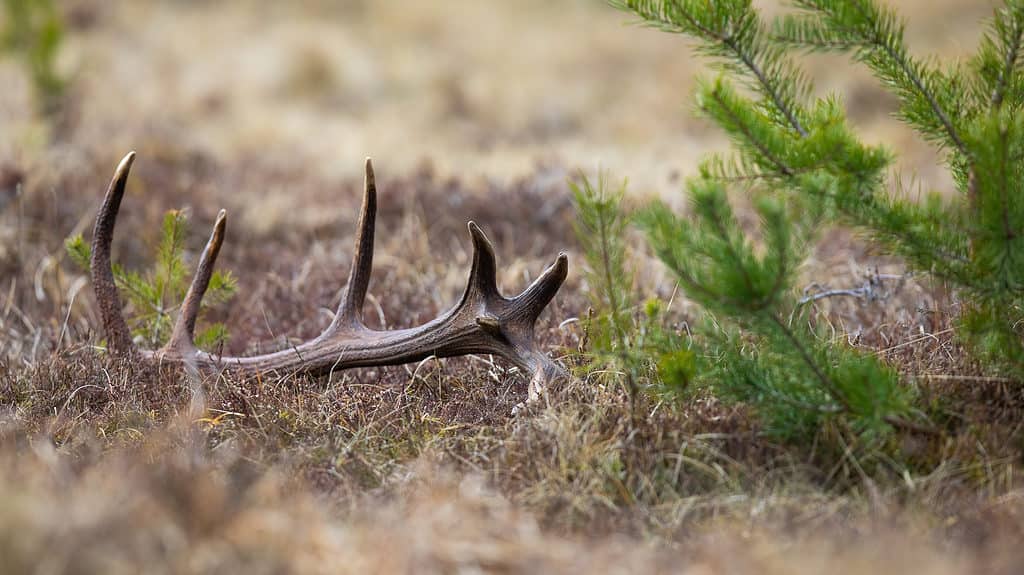Antlers are defined as the branched extensions of bones that grow and emerge from an animal’s skull.
Antler Summary
Antlers are only found on members of the family Cervidae. This includes deer and similar animals, like moose. They are extensions of an animal’s skull that emerge from the top of their heads. Typically, only male animals in the family Cervidae have antlers. However, some species, such as reindeer (also known as caribou), may grow antlers as females. These usually aren’t identical to those of male individuals, however.

Antlers are extensions of the skull bone that form into branches, called tines.
©Mega Pixel/Shutterstock.com
Antlers are shed each year, only to regrow in the following year. They are more than just decorations, however, with Cervidae animals using their antlers to attract mates, protect themselves, or compete with rivals.
Because there are many different species of Cervidae, not all antlers are created equal. However, they do share similar characteristics and functions that differ from other, similar bodily structures, such as horns.
What are antlers made of?
Antlers are made of a variety of materials, although it varies depending on the stage of growth. Overall, they are made of six components: bone, cartilage, tissue, skin, nerves, and blood vessels.
When antlers first emerge, they are covered in a thin, furry membrane known as velvet. This is used to protect the growing bones within, as well as the blood vessels and tissues. Once the bone dies, the velvet is no longer needed and is shed.
The difference between antlers and horns
Antlers are not the same as horns. As a result, before learning more about the different animals that have antlers, it is important to learn about animals that don’t have antlers. Instead, some species that seem like they have antlers have horns and vice versa.
Although horns and antlers look similar, and may even seem to be identical, there are actually several significant distinctions that set these two parts apart.
Antlers are solid bone. They’re a single, branching bone that extends from the animal’s skull and grows outwards. The individual branches on an antler are known as tines, although some people may refer to them as points. When antlers are first growing, they are considered living bone. During this time, they’re covered in a thin layer called velvet with nerves and blood that feed nutrients to the bone to help it grow. Eventually, the bone will die, and the animals will shed their antlers each year.
Horns are quite different.
Where antlers are a single bone, horns are built out of two different parts. First, there is a boney core that grows from the animal’s skull, just like antlers. However, there is also a second part: a keratin sheath. Keratin is the same material that makes up many parts of the human body, such as hair and nails.
Whereas antlers are shed annually, horns are not. The only exception to this rule is in the case of pronghorn antelopes, who will shed their horns. While the boney core of the horn may not be shed, there are times when the keratin sheath is shed. The main structure of the horn remains, however.
Animals with Antlers
Antlers are found only in animals in the family Cervidae, known as cervids. This is because these species descended from ancestors that originally had tusks. That’s why in some species of cervids, such as the Chinese water deer (or vampire deer) and the muntjac, tusks are still present. However, in other species, these tusks have been completely replaced by antlers. In species like the muntjac, where both tusks and antlers are present, the antlers are smaller than in other cervids.

The Indian muntjac (Muntiacus muntjak), also called Southern red muntjac and barking deer, is a deer species native to South and Southeast Asia that has antlers
©PLOO Galary/Shutterstock.com
Typically, the only animals found with antlers are males of different species. However, antlers are not uncommon in female reindeer or caribou. While females of this species, known as does, can develop antlers, they’re smaller than those of male species.
This does not mean that females of other species cannot grow antlers, however; it just means that is uncommon. Most does have the ability to produce antlers, though not to the same extent or size as males. Antlers on does in any other species outside of caribou and reindeer can usually be attributed to increased testosterone.
Animals with antlers include
- Black-Tailed Deer
- Caribou
- Manitoban Elk
- Moose
- Rocky Mountain Elk
- Roosevelt Elk
- Tule Elk
- White-Tailed Deer
There are 55 total species in the family Cervidae. There are only three regions where they are not found: Australia, Antarctica, and in certain regions of Africa such as the Sub-Saharan area.

The Cairngorm reindeer has velvety antlers of impressive size.
©doliux/Shutterstock.com
What are a deer’s antlers called?
Antlers aren’t the only name for a deer’s antlers. While other names may not be as common in different species of cervids, it is in reference to different species of deer. Once a deer grows a complete set of antlers, that is the velvet is shed and there is no more growth, it is known as a rack.
However, not all deer racks are the same. There are typical racks, which have all tines (or points) growing upwards in a healthy, normal manner. Then, there are abnormal tines, which can disrupt typical racks. These are tines that grow from another tine rather than the main frame of the antlers that emerge from the skull.
Do animals feel pain in their antlers?
Antlers are a type of growing bone. When they are still covered in velvet, they have an active flow of blood and nerves. During this time, cervids’ antlers are extremely sensitive, and these animals will be able to feel pain in their antlers.
However, once the velvet is shed, this is a sign that the bone has died. There are no longer any active nerve endings or blood flow in the antlers. As a result, at this point, animals don’t feel pain in their antlers. This allows for cervids to fight with them without extreme amounts of pain.
Do antlers fall off each year?
As mentioned previously above, cervids shed their antlers every year. This means that they spend a large period of the year dedicating nutrients and energy to growing antlers, existing for a period with their antlers, and then losing them. The next year, the cycle repeats.
Because of this, antlers are actually seen as a liability or handicap for cervids. This is because it can take a large amount of energy and nutrients away from other important life processes to grow these antlers every year. This also means, however, that antlers can be a glimpse into the health of an animal with them. Animals that are struggling to regrow their antlers may have issues with their metabolism. Or, on a simpler level, they could even have a difficult time gathering food in order to prepare for this regrowth.
Studies have been conducted to determine more about the shedding behaviors of animals with antlers. This also includes studying regrowth. Each year, animals will regrow their antlers. However, as the animal matures and finds their footing in their habitat, between finding mates and establishing food sources, they are able to better focus on this regrowth. This allows for antlers to grow larger with time. Or, in times of hardship, smaller.
Why is shedding important?
However, it is also important to understand why shedding occurs. At a first glance, it makes sense that antlers would be for protection and combat, such as during male-male competition over the availability of mates. However, during this time, it is not uncommon for antler fractures to occur.
During some encounters, a single tine may break apart from the main structure of the antler. In other cases, an entire antler may be lost to a fracture. The important thing to understand about antlers is that, once the velvet is gone, they are no longer living bones. As a result, they lack the ability to heal and repair themselves in the instance of fractures and breaks.
Shedding, then, allows for males to maintain their antlers. When a horn is damaged, there is still a living, boney core beneath the keratin sheath that can heal itself. This is not the same for males with antlers. As a result, if they were not to shed their antlers periodically, it could have a devastating impact on their ability to mate. Fractures would never heal, and it would be uncommon to find cervids with full antlers.
As a result, shedding gives males the ability to begin each mating season with a new set of antlers that no longer bear the signs of last year’s season. They can begin with no damage, no missing tines, and no fractures. At the same time, they’re able to grow larger antlers with more complex branching.
Can I collect shed antlers?
Because antlers are bone, they are made mostly of calcium. As a result, once antlers are shed, they don’t break down and decompose in the soil like soft tissue and flesh may. Some animals may carry out antlers to chew or gnaw on, but there are still hundreds of pairs available each season.
As a result, gathering shed antlers is a common practice. This is a practice that appeals to many people who are interested in collecting bones and antlers but have no desire for hunting itself. Shed hunting involves trekking into the wilderness during the winter when cervids begin to shed their antlers. Because antlers may not shed at the same time, it is rare to find a pair from the same male at the same time or place.
The North American Shed Hunting Club was founded in 1991 for this practice.
Although shed antlers are no longer attached to the deer or other animals anymore, however, shed hunting is not as simple as walking into the forest and collecting these discarded bones. Since sheds come from wildlife and game, in many places, there are still regulations about collecting any animal parts.

Because antlers are made primarily of calcium, they do not decompose once shed.
©Wild Media/Shutterstock.com
In order to learn if you can collect shed antlers, reach out to your local government. For some areas, you may be free to take shed antlers as you please. In others, you may need permits. There are even some regions where shed hunting is prohibited. In Canada, for instance, shed hunting in national parks is a crime, as these antlers are considered by law to belong to the people and ecosystems of the country.
Antlers and DNA
One of the most interesting parts of antlers is their ability to provide scientists with DNA. Because antlers are a single structure of bone that is grown from the skeleton like any other limb or feature, they contain DNA. Because of this fact, scientists are able to collect antlers and learn more about the animals from which they come from.
Not only this, however, but by learning more about the DNA provided in shed antlers, scientists are able to better understand the impact of natural weathering and decomposition on DNA yield. As of right now, scientists have been able to collect usable DNA from samples up to seven years old. After eight years of weathering, however, the DNA becomes unusable.



